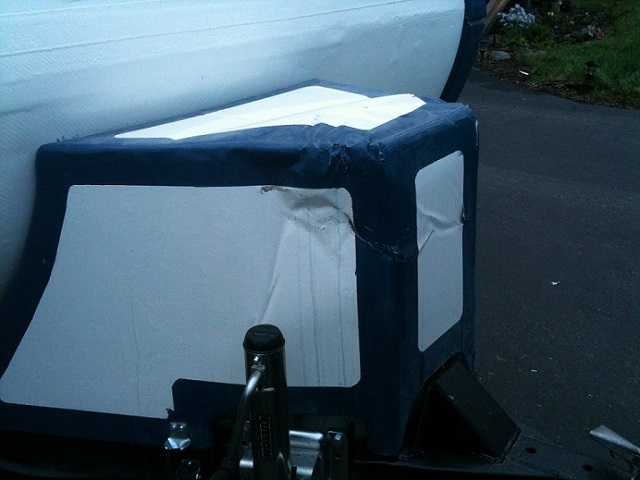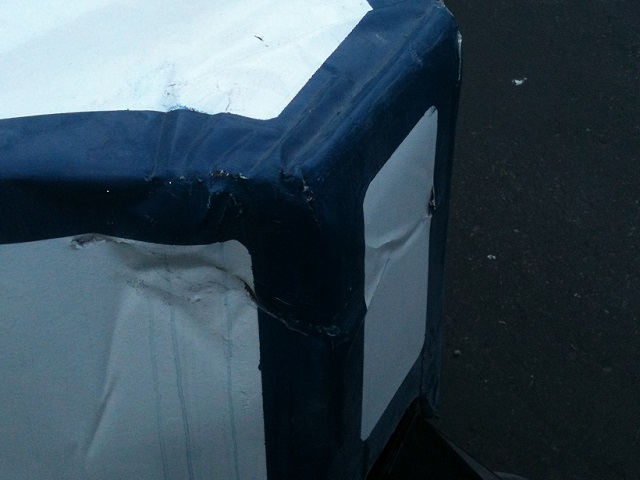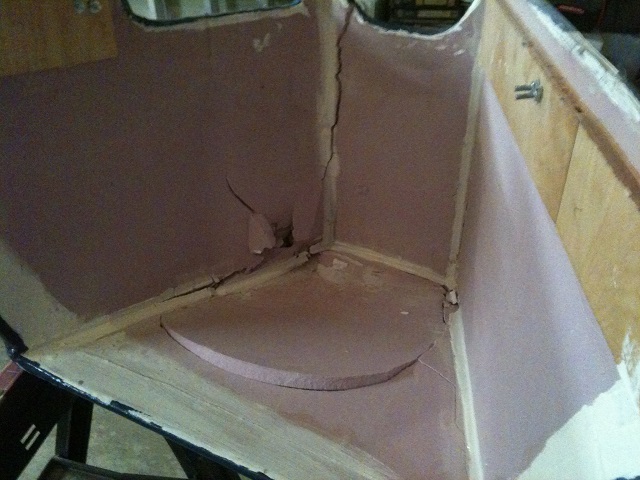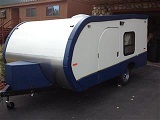So those of you who have read this thread previously may remember that at the outset of the maiden voyage, I had a wheel go flying off at about 30 mph. It did cause minimal damage to one of the side walls but otherwise no damage and the trip went very well. The Road Foamie is amazing to tow, is rain tight, nearly soundproof and plenty roomy for my wife and I and our two dogs. We went out for our second road foamie trip and for a second time we had a mishap. This time, the Road Foamie came unhitched while we were driving along a gravel road at about 45 mph and I hit a poorly marked and very rough RR crossing. (Yes, I know... WAY too fast for the conditions...



) It seems I had not put in the coupling lock pin. DUUUHHHHH!!!!!




. I brought the truck and now unhitched trailer to a gradual stop and stepped out to see the damage. The safety chains did their job (mostly) holding the trailer tongue just high enough off the ground to prevent a major catastrophe. The cowling on the nose of the trailer (a new addition) was pushed up against and under the rear bumper. I also had damage to the crank handle of the trailer tongue jack which rendered it inoperable. Luckily, I had my floor jack to jack up the trailer and get it rehitched, put in the lock pin (which was at the time of the incident, sitting unused in the cab of my truck) and proceeded on the way. This is what the damage to the 3/4" foam and fiberglass cowling looks like:

You can see that it is still in one piece. It is a bit worse off for wear, but it did not crumble into a billion pieces and retained it's essential shape

A bit of a closer look at the damage

A look at the damage from the inside. I think the sock which is fiberglass in this case, did it's job which is to hold everything together. Without the sock, it looks like it would have broken into pieces. It is also just on the exterior. If it had been fiberglassed on the inside, the damage might have been to the bumper of the truck



So as bad as this is, I think it serves as empirical proof of our theories. This is indeed a strong way to build. This cowling took a big hit, stayed intact, retained its' shape, stayed in place and may have protected the propane tank that sits right in the front of the cowling. I never designed it to do that, but it looks like that's what it did. So bring on the bears, flying turkeys and the hammers. This foam that we're using, when encased by the sock and without even making a composite panel is indeed, strong stuff. If it were an aluminum cowling, it would have bent out of shape, probably not stayed in place and would have damaged my bumper on the truck. If the cowling were commercial fiberglass, it would have broken up and perhaps shattered, not retained it's shape and may have left gouges in the truck bumper. With the exception of the tongue jack which has already been replaced, there is no damage to the Road Foamie.
I told my co-workers this story and after having a few good laughs at my expense about Asian drivers and the need to restrict my access to trailers, they did admit to the strength of the build. This Foamie has endured two major thumps and has suffered no significant damage to the trailer itself. Would I recommend this building method? ABSOLUTELY!!! Will I do a better job of making sure I get the running gear right before the next trip in two weeks? ABSOLUTELY!!!





 Right !!!!
Right !!!! 





 . I brought the truck and now unhitched trailer to a gradual stop and stepped out to see the damage. The safety chains did their job (mostly) holding the trailer tongue just high enough off the ground to prevent a major catastrophe. The cowling on the nose of the trailer (a new addition) was pushed up against and under the rear bumper. I also had damage to the crank handle of the trailer tongue jack which rendered it inoperable. Luckily, I had my floor jack to jack up the trailer and get it rehitched, put in the lock pin (which was at the time of the incident, sitting unused in the cab of my truck) and proceeded on the way. This is what the damage to the 3/4" foam and fiberglass cowling looks like:
. I brought the truck and now unhitched trailer to a gradual stop and stepped out to see the damage. The safety chains did their job (mostly) holding the trailer tongue just high enough off the ground to prevent a major catastrophe. The cowling on the nose of the trailer (a new addition) was pushed up against and under the rear bumper. I also had damage to the crank handle of the trailer tongue jack which rendered it inoperable. Luckily, I had my floor jack to jack up the trailer and get it rehitched, put in the lock pin (which was at the time of the incident, sitting unused in the cab of my truck) and proceeded on the way. This is what the damage to the 3/4" foam and fiberglass cowling looks like: 




 Foam is tough ... no need for more testing ...
Foam is tough ... no need for more testing ...  The good news is that anyone who doubts the strength can clearly see their doubts are misplaced.
The good news is that anyone who doubts the strength can clearly see their doubts are misplaced.
